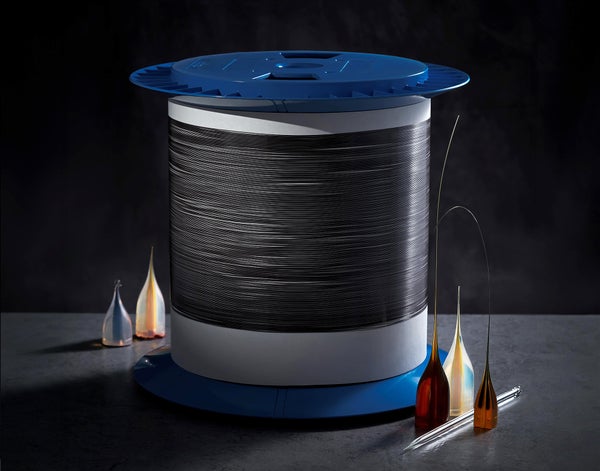A team of electrical engineers and fabrics scientists has invented a hat that tells its wearer when it’s safe to cross the road. The researchers’ proof-of-concept beanie is knitted with germanium fibers that can sense changing traffic lights—and tell pedestrians with visual impairments when they’re clear to walk. This prototype shows how fibers with a semiconductor core can be woven into functional garments that gather, process and store information, and it may one day lead to computers that can be worn like clothes.
Fabricating conductive fibers that are flexible enough to use in clothing is no simple matter. Crystalline forms of the elements silicon and germanium—prized by the wearable electronics industry for their optical and electrical properties—must be encased in a protective cladding and then spun into durable strands. Previous attempts that used a process called thermal drawing could only produce strands that were typically too short (usually no longer than a few tens of centimeters) and left fractures or other disabling flaws in the cores. But now, for the first time, researchers have developed a method that creates long, flexible fibers with intact light-detecting and electronic properties—as the woven beanie proved. The team described these results in a recent study in Nature.
In a typical thermal drawing process, silicon is placed inside a glass tube and heated until both materials are soft enough to stretch into thin fibers. But “because the silicon and the glass outer jacket are totally different, when we heat them up, they will show completely different behaviors” in their ability to stretch, says the new study’s senior author Lei Wei, who researches functional fabrics at Singapore’s Nanyang Technological University. The difference in how these materials expand or shrink can stress the fibers and break their semiconductor core. “Stress is the killer,” Wei says.
On supporting science journalism
If you're enjoying this article, consider supporting our award-winning journalism by subscribing. By purchasing a subscription you are helping to ensure the future of impactful stories about the discoveries and ideas shaping our world today.
To address this problem, Wei and his team brought in mechanical engineers to help identify the forces at play in each step of the heating and stretching process. “We used their theory to guide our selection of the materials,” Wei says. Once the study authors found the right combinations, they were able to make fibers that survived the fabrication process without defects or breaks, as they reported in Nature.
By placing silicon inside silica glass and germanium within aluminosilicate glass, the researchers produced continuous fibers that were about 100 meters long. Next they etched away the glass cladding and heated and stretched the fibers again, this time embedding the semiconductor cores inside a polycarbonate plastic. “The fibers are super flexible,” Wei says, so they can be knitted or woven with fabrics such as cotton, wool or silk into “functional textiles. “The researchers produced a prototype fabric that was about a meter wide and 10 meters long. The fibers worked underwater and survived other durability and compression tests as well.
Xiaoting Jia, who leads a research group on smart fibers and wearable devices at Virginia Tech, says this work will pave the way for larger-scale production of silicon- or germanium-based semiconductor fibers. The inclusion of the polymer layer, she says, adds flexibility and insulation and protects the fiber when it is woven or knitted into a fabric. “It becomes a very robust and scalable process,” adds Jia, who wasn’t involved in the study but co-authored an accompanying commentary about the research in Nature.
Potential applications include optical technology—such as the light-sensing hat. The beanie’s fibers feed data to a small interface board in the hat’s interior. This board communicates with an app that makes the wearer’s smartphone vibrate differently to indicate when a traffic light has turned red or green.
Another prototype created by the team is a sweater that incorporates silicon optoelectronic fibers. The garment receives and sends data using light-fidelity (Li-Fi) communication. In the study, information, in this case a photograph of a building, was converted to binary code and transmitted by the sweater as pulses of light. The researchers also demonstrated a flexible watchband that monitors heart rate.
Thanh Nho Do, an expert in soft robotics and functional materials, who directs the University of New South Wales Medical Robotics Lab in Australia and was not involved in the study, says the new technique produces semiconductor fibers that are strong enough to be woven by hand or machine—and are suitable for large-scale manufacturing. “It can open new possibilities to integrate more functions,” he says, such as sensors that detect pressure or temperature or controls for soft robots.
The new findings can guide researchers in selecting materials and designing structures for more complicated semiconductor-core fibers made of other elements, Wei says. His team has kept its structures simple for now, but future textiles could double as more complex devices. One ongoing project involves trying to turn the fibers into transistors: a necessary step toward being able to weave a computing device. Though the first prototypes are limited to sensors, Wei is optimistic a wearable computer could come in the future.
